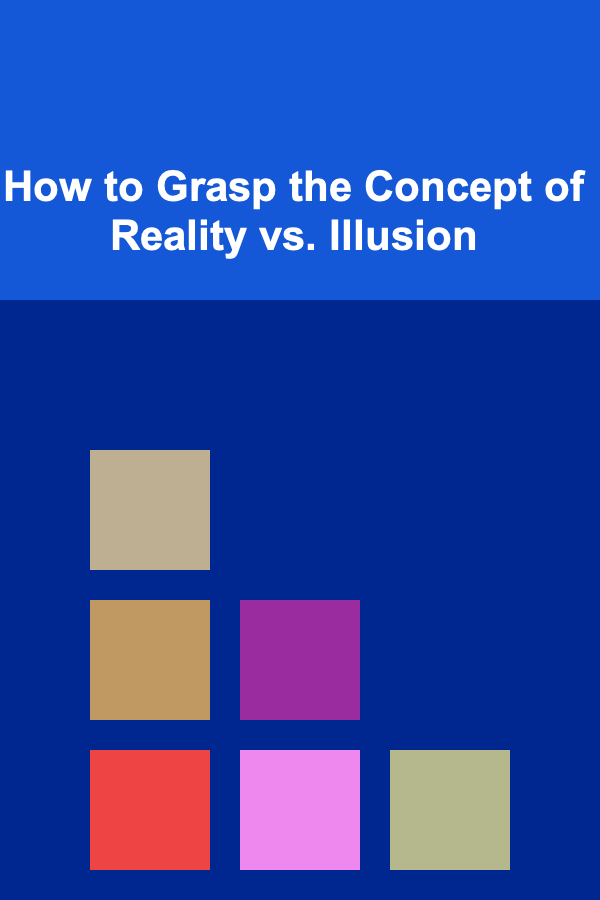
How to Grasp the Concept of Reality vs. Illusion
ebook include PDF & Audio bundle (Micro Guide)
$12.99$10.99
Limited Time Offer! Order within the next:

In human history, the distinction between reality and illusion has sparked philosophical debates, psychological inquiry, and artistic exploration. It is a concept that has intrigued thinkers for millennia, from Plato's allegory of the cave to modern-day discussions about perception, consciousness, and the nature of existence. The concept of "reality" refers to everything that exists, independent of our perceptions or beliefs, while "illusion" is something that deceives or misrepresents the truth. But what does it mean to grasp this concept fully? How do we differentiate between what is real and what is merely an illusion?
This article explores the intricate relationship between reality and illusion, investigating how our mind constructs our experience of the world, and how understanding this relationship can reshape our perception of existence. We will delve into philosophical views, psychological studies, scientific insights, and even artistic interpretations to offer a comprehensive understanding of this compelling dichotomy.
The Nature of Reality: A Philosophical Exploration
Philosophically, the question of what is "real" has been a central topic for centuries. Ancient Greek philosophers, like Plato, were among the first to ponder the distinction between reality and illusion. In his famous "Allegory of the Cave," Plato suggests that what we perceive as real is simply the shadow of a deeper, more genuine reality. The prisoners in the cave, bound and forced to watch shadows cast on the wall, perceive these shadows as the only reality. In this allegory, Plato uses the cave as a metaphor for human perception, arguing that most people live in ignorance of the true nature of existence, mistaking illusions for reality.
Idealism vs. Realism
The philosophical battle between idealism and realism provides an essential framework for understanding reality. Idealists believe that reality is mentally constructed and that everything, including the physical world, is a product of consciousness. Realists, on the other hand, argue that the external world exists independently of our perceptions. The famous philosopher Immanuel Kant proposed a middle ground between these two extremes, suggesting that while the world exists outside of us, our knowledge of it is limited by the faculties of our mind. According to Kant, reality is shaped both by the external world and by the way our minds interpret it.
In more contemporary philosophy, thinkers like Jean Baudrillard and Jacques Derrida have questioned the very idea of an objective reality. Baudrillard's theory of hyperreality posits that in today's world, media, technology, and consumer culture have created a situation where the line between reality and illusion has become blurred. In this "hyperreal" world, simulations and representations replace actual experiences, creating a new kind of reality that is far removed from the original truth.
The Psychological Perspective: How Our Minds Create Reality
From a psychological standpoint, reality is not something we passively perceive but rather something actively constructed by our minds. Cognitive science suggests that what we experience as "real" is, in fact, a construction of our brain based on sensory data, memories, and past experiences. The brain constantly processes incoming information and builds a model of the world that allows us to interact with it effectively. This model is, however, inherently flawed and influenced by various biases, leading to illusions about the world.
The Role of Perception
Perception plays a crucial role in distinguishing reality from illusion. Our senses---sight, hearing, touch, taste, and smell---provide us with information about the external world, but these senses can be easily deceived. Optical illusions, for instance, trick our visual system into seeing something that is not there, such as the famous "duck-rabbit" image that can be seen as either a duck or a rabbit depending on how you look at it. Similarly, auditory illusions can make us perceive sounds that don't exist or misinterpret sounds we do hear.
The brain's reliance on context, expectations, and prior knowledge can also lead to perceptual distortions. The phenomenon of pareidolia, where we see faces in random objects, is a prime example of how our brain tends to impose patterns on ambiguous stimuli. In this sense, the mind often creates illusions by interpreting the world in a way that conforms to its own preconceived ideas.
Cognitive Biases and Distortions
Our minds are filled with cognitive biases that shape our perception of reality. Confirmation bias, for example, is the tendency to seek out and give more weight to information that confirms our existing beliefs, while ignoring or dismissing contradictory evidence. This bias can lead to distorted views of the world and create illusions of truth, reinforcing false or incomplete understandings of reality.
Another cognitive distortion is the Dunning-Kruger effect, where individuals with limited knowledge or skills in a particular area tend to overestimate their abilities. This illusion of competence can have serious consequences, as it prevents individuals from recognizing their own limitations and can result in poor decision-making.
The Role of Culture and Society in Shaping Reality
Our understanding of reality is not formed in isolation but is heavily influenced by the culture and society in which we live. Social norms, language, and cultural practices all contribute to shaping our perception of the world. For example, the concept of time is understood differently across cultures---while Western societies often view time as linear and finite, some Indigenous cultures see time as cyclical and interconnected.
In modern society, media and technology have a particularly strong influence on our perception of reality. The rise of social media platforms has created a world where images, stories, and opinions are constantly curated and filtered. This "curated reality" can distort our perception of ourselves, others, and the world, blurring the line between what is real and what is an illusion. Social media platforms often promote idealized versions of life, leading individuals to compare their reality to an unrealistic, distorted version of other people's lives.
The Science of Illusions: Neuroscience and Perception
Illusions are not just psychological phenomena; they have a basis in neuroscience. Our brains are wired to process information efficiently, but this efficiency often comes at the cost of accuracy. The brain relies on shortcuts, called heuristics, to make sense of the vast amount of sensory information it receives. While these shortcuts are generally helpful, they can also lead to systematic errors in perception.
For example, the brain's tendency to rely on the principle of "top-down processing" means that it interprets sensory input based on existing knowledge and expectations. This can lead to perceptual illusions, where the brain "fills in the gaps" with information that doesn't correspond to reality. The famous "rubber hand illusion" is an example of how the brain can be tricked into accepting a false perception. In this experiment, participants experience the sensation of touch on a rubber hand while their real hand is hidden from view. Over time, their brain comes to accept the rubber hand as their own, illustrating how malleable perception can be.
Neuroscience has also shown that the brain is capable of generating its own illusions, especially in the form of hallucinations. Hallucinations can occur in a variety of contexts, such as during sleep deprivation, sensory deprivation, or in certain mental health conditions. These experiences highlight how the brain can create vivid perceptions that are entirely detached from external reality.
Illusions in Art and Literature: Questioning the Nature of Reality
Art has long been a medium through which reality and illusion are explored. Surrealist artists like Salvador Dalí and René Magritte challenged traditional perceptions of reality by creating dreamlike, illogical scenes that defied the laws of nature. Their works questioned the boundaries between the real and the imagined, inviting viewers to reflect on the subjective nature of experience.
In literature, authors like Jorge Luis Borges have used fantastical elements to blur the line between reality and illusion. Borges' short story "Tlön, Uqbar, Orbis Tertius" tells of a fictional world that is gradually "created" by a secret society, and as the story unfolds, it becomes unclear whether Tlön is a real place or a purely imaginary construct. This narrative highlights the power of language and perception in shaping our understanding of reality.
The concept of "the unreliable narrator" in literature further explores the idea that our perception of reality can be flawed. In works like William Peter Blatty's The Exorcist and Kazuo Ishiguro's The Remains of the Day, readers are forced to question the truth of the narrative as presented by the protagonist, leading them to confront the idea that reality is subjective and open to interpretation.
Grasping Reality vs. Illusion in Everyday Life
To grasp the concept of reality versus illusion in everyday life, we must first recognize that our perception of the world is inherently subjective. We each see the world through the lens of our individual experiences, beliefs, and biases. The key to understanding the difference between reality and illusion lies in cultivating self-awareness and questioning the assumptions we hold about the world.
Mindfulness and meditation practices can help individuals become more aware of their thought patterns and the ways in which their mind distorts reality. By observing thoughts without judgment, one can begin to discern between what is based on objective reality and what is influenced by illusions or biases.
The Importance of Skepticism
A healthy level of skepticism is crucial in navigating the world of reality and illusion. This doesn't mean doubting everything, but rather questioning the sources of information we encounter and being open to alternative perspectives. In an era where information is readily available, it is essential to critically evaluate the truthfulness of the data we consume, especially in the digital age where misinformation and "deepfakes" can easily blur the line between what is real and what is fabricated.
Conclusion
The concept of reality versus illusion is complex, multifaceted, and deeply intertwined with our understanding of consciousness, perception, and existence. Through philosophy, psychology, science, and art, we can explore the many ways in which reality is constructed and how our minds often deceive us into seeing illusions as truth. By questioning our perceptions, being mindful of our biases, and embracing a more nuanced understanding of reality, we can gain greater clarity in distinguishing between what is real and what is illusory. This process of self-awareness and critical thinking is not only key to grasping the concept of reality and illusion but also essential for living a more conscious and authentic life.

How to Start Saving Money on Baby Diapers and Wipes: Budget-Friendly Strategies
Read More
How to Tackle Spring Cleaning with a Detailed Checklist
Read More
How to Use Analytics Tools to Measure Productivity
Read More
How to Use Feng Shui Principles in Home Staging
Read More
How To Make Your Own Cleaning Supplies: A Comprehensive Guide
Read More
10 Tips for Handling Error States in Voice User Interfaces
Read MoreOther Products

How to Start Saving Money on Baby Diapers and Wipes: Budget-Friendly Strategies
Read More
How to Tackle Spring Cleaning with a Detailed Checklist
Read More
How to Use Analytics Tools to Measure Productivity
Read More
How to Use Feng Shui Principles in Home Staging
Read More
How To Make Your Own Cleaning Supplies: A Comprehensive Guide
Read More